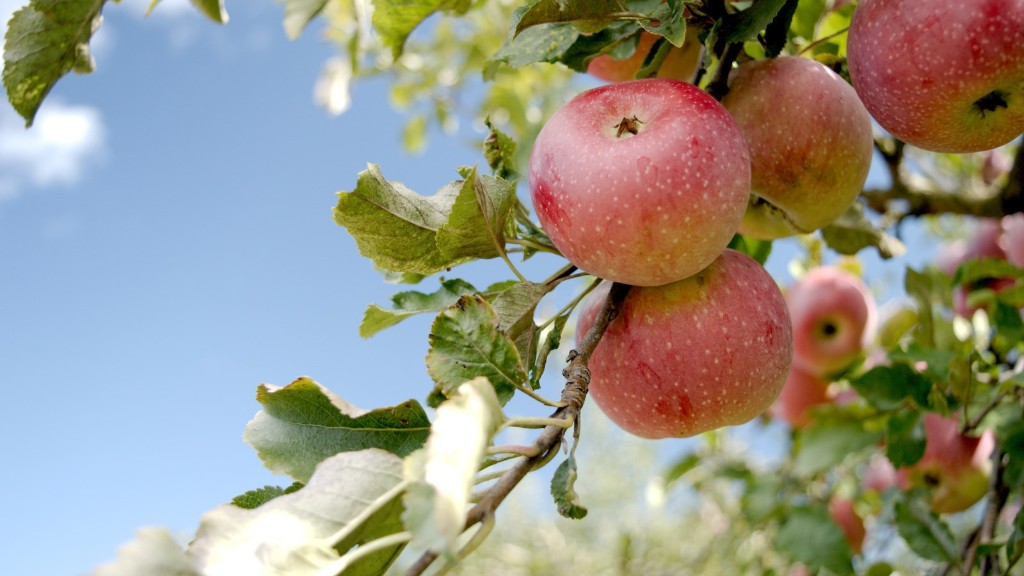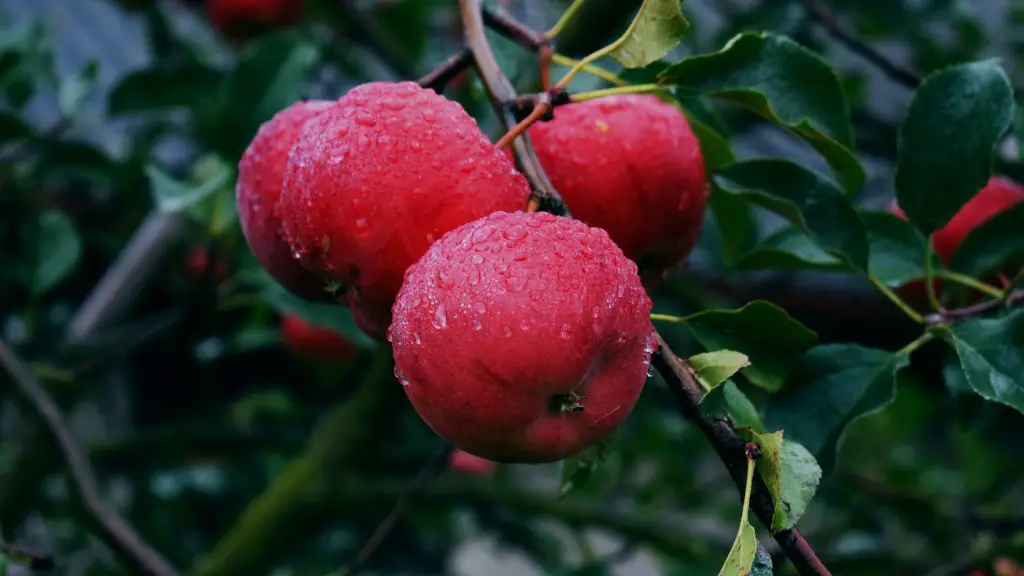Taking care of a young apple tree is essential for producing a healthy and abundant harvest of delicious fruit. Proper care of apple trees, when done correctly, can result in many years of healthy fruit production. To successfully take care of a young apple tree, gardeners must provide the tree with the proper light, soil, water, and nutrition. Let’s take a look at these fundamental requirements and learn how to properly care for a young apple tree.
Selecting the proper location for an apple tree is key. Apple trees need lots of sun to produce the best harvest, so selecting a sunny spot in the yard that gets at least six hours of sunlight is ideal. The fruit tree should also be visible, so gardeners can monitor its growth and health.
The soil in which the apple tree is planted is also crucial. Apple trees require a rich, well-drained soil with a neutral pH, or a pH between 6.0 and 7.0. Also, locations should be chosen that are not prone to flooding, as apple trees do not do well in standing water. Organic matter should also be added to the soil before the tree is planted.
Water is an important component when it comes to the health and growth of apple trees. Young tree should be watered approximately every three to five days during the dry season, and more often during extremely hot weather. If a young tree has not received enough water, its fruits will have a smaller size.
Fertilizer is necessary as trees age, usually beginning after the first year. Fertilizers are important, as they supply the tree with essential nutrients like nitrogen, phosphorous, and potassium. When applying fertilizer, it is important to read the directions and follow them carefully. Too much fertilizer can damage apple trees and the fruit they produce.
Mulching is also beneficial to young apple trees. It helps retain moisture in the soil, keeps weeds from growing around the tree, and keeps the tree from frost injury in the winter months. Mulching should be done in early spring, and 2-4 inches should be applied around the tree. Organic mulch is best for apple trees.
Finally, proper pruning helps young apple trees grow and flourish. This should be done twice a year, in the summer and in the winter. Pruning helps open up crowns and encourages new fruits to form. An expert in pruning should be consulted before attempting it.
Hand Weed and Prune
When taking care of a young apple tree, it is important to weed and prune. Hand weeding around the roots of the tree is the best practice for controlling weeds and preventing damage to the tree. Picking out weeds by hand is also the safest way to ensure no damage is done to the apple tree.
Pruning is also important for young apple trees. Pruning helps promote growth and shape of the tree. Apple trees can be pruned twice a year. Pruning in summer helps remove dead wood, while winter pruning is used to prevent disease and boost flowering of the tree.
When pruning, use the right tools. Pruning shears, loppers, saws, and other pruning tools should be used. It is important to sterilize tools between each prune to prevent transmitting disease.
When pruning, start by removing dead or damaged wood. Make sure to cut at an angle and just above a bud to encourage more growth. Pruning should be done in the evening to prevent excessive transpiration, or loss of water from leaves, flowers, or fruit.
Also, pruning should be done carefully to create an open center so that airflow can circulate and sun can reach the branches. Removing inward-growing branches help open up the center of the apple tree, creating airflow and promoting growth.
Snipping away unnecessary water sprouts or suckers also helps promote strength and reduce the number of flowers. Pruning unwanted growth prevents trees from overgrowing, forcing the tree to put its energy into producing a healthier and nicer harvest of fruit.
Pest Management
Apple trees are susceptible to pests, so it is important to monitor and take steps to protect the tree against damage. Proper monitoring of the apple tree will help prevent infestations and disease growth, and allows a gardener to take prompt action if a problem is spotted.
Common apple pests include aphids, mites, and codling moth. Aphids and mites suck the sap from the leaves, making it more difficult for the tree to survive. Codling moth, whose larvae feed on the developing fruit, is a major menace to apple growers.
Organic and chemical treatments can be used to deal with pests. Biological controls such as ladybugs, wasps, spiders, and lacewings can be used to control pests and their larvae. Neem oil is an organic fungicide that can be used to control mites and other pests. For more stubborn pests, chemical sprays that contain insecticides, acaricides, and fungicides may be used.
Aphid management includes releasing beneficial insects such as ladybugs, wasps, and parasites. Spraying with insecticidal soap can also help. Spraying with insecticidal soap and water mixture should be done at least twice during the growing season.
Mites can be managed by avoiding excess nitrogen applications and over-watering, as they thrive in moist conditions. If the tree has become infested with mites, spraying with insecticide can help.
Codling moth can be managed by trapping the adult moths early in the season with sticky traps and pheromones. Spraying a mineral oil or kaolin clay mixture will also help deter the moths.
Fruit Harvest
When taking care of a young apple tree, it is important to understand how and when to harvest fruit from the tree correctly. Typically, apple trees will begin to bear fruit within two years of planting. Experienced gardeners know when the fruit is ready by examining the size, color, and flavor.
When harvesting fruit from a young apple tree, it is important to be gentle and use pruning shears or a knife to cut the fruit off of the tree if necessary. It is also important to harvest the fruit at the right time. If it is too early or too late, the fruit may not be as flavorful.
Another tip when harvesting fruit is to clear away fallen fruit from around the base of the tree. Collecting and discarding the fallen fruit will help prevent fungal diseases and unwanted pests. Fallen fruits should be removed within a couple of days to avoid further spread of diseases or infestation.
The majority of apples are harvested at peak maturity when the colors are fully developed and the skin resists the pressure from your thumb. If the apples are not yet ripe, they can be stored in paper bags in cool and dry places to complete the ripening process.
Winter Care
A young apple tree needs care even in cold weather. To help a young apple tree survive during the winter months, a gardener must act fast when the temperatures start dropping. This includes giving the tree extra insulation through mulching, protecting it from cold winds with a wind break, and ensuring it has enough water to survive the winter.
Mulching helps protect the young apple tree’s roots and acts as an insulator by conserving heat. A thick layer of organic mulch, like straw, hay, or bark, should be applied around the tree after temperatures drop below 40 degrees Fahrenheit. This will help give the young tree extra insulation during cold winter months.
Having a wind break also helps protect the young apple tree from cold winter winds. A wind break can be made from materials like burlap, cardboard, or even chicken wire. A wind break can also help protect young trees from hail or heavy snow.
Finally, young apple trees require adequate amounts of water during winter months. Deep irrigation is important for young trees, especially when the water sources have frozen. Water that is loaded with nutrients will help young trees survive during cold temperatures and will help them prepare for a strong growing season in the spring.
Tree Diseases
When caring for a young apple tree, it is important to be aware of the tree diseases that can affect it. Apple trees are particularly susceptible to a wide variety of diseases, including canker diseases, diseases caused by bacteria and fungi, and viral diseases.
Canker diseases are some of the most destructive diseases that can attack apple trees, causing stems and branches to become infected. Canker diseases can also cause leaves to wilt and entire branches or sections of the tree can become infected. Canker diseases are caused by both insect pests and fungal spores.
Bacterial and fungal diseases can cause serious trouble for young apple trees as well. These diseases can cause leaves to yellow and fall off, as well as affect the size and flavor of the fruit. These diseases also make the tree more susceptible to pests and damage from cold weather.
Viruses can also be transmitted to young apple trees through insects, and they often cause distorted or discolored leaves. If a plant is infected by a virus, it is best to remove and discard the infected plant in order to prevent the virus from spreading.
Apple scab is another disease that can affect apple trees. Apple scab is caused by a fungus, and it will cause leaves and fruit to be covered with a dark scab-like lesions. The fungus can also cause leaves to turn yellow and drop prematurely. To prevent apple scab, it is important to plant disease-resistant varieties and remove any infected leaves.
Pruning and Trimming
When taking care of a young apple tree, pruning and trimming are important activities. Pruning and trimming help to shape the tree and train it to grow in a certain direction. Pruning and trimming can help improve the tree’s health, promote fruiting and flowering, increase sunlight, and control pests and diseases.
Apple trees should be pruned every few years to keep the shape and size of the tree under control. Pruning should be done in the early spring before the tree starts to flower. Pruning too late in the season can lead to lower fruit production and can encourage disease growth.
When pruning, it is important to use the right tools. Pruning shears, loppers, saws and a sharp knife should all be used to achieve the desired shape and size. Sharp tools will make a cleaner cut, which helps prevent disease and encourages healthy growth of new branches.
Trimming helps reduce the size of branches and keeps them from growing out of control. When trimming branches, it is important to make the cuts at a slight angle, just above an outward-facing bud. This encourages new growth and helps create an open crown, which helps improve air circulation.
Finally, thinning the branches helps allow light and air to penetrate the tree. Thinned branches will receive more sunlight and water, which increases the amount of flowers the tree produces. Thinning is best done after the bloom period, when the fruit is beginning to set.




